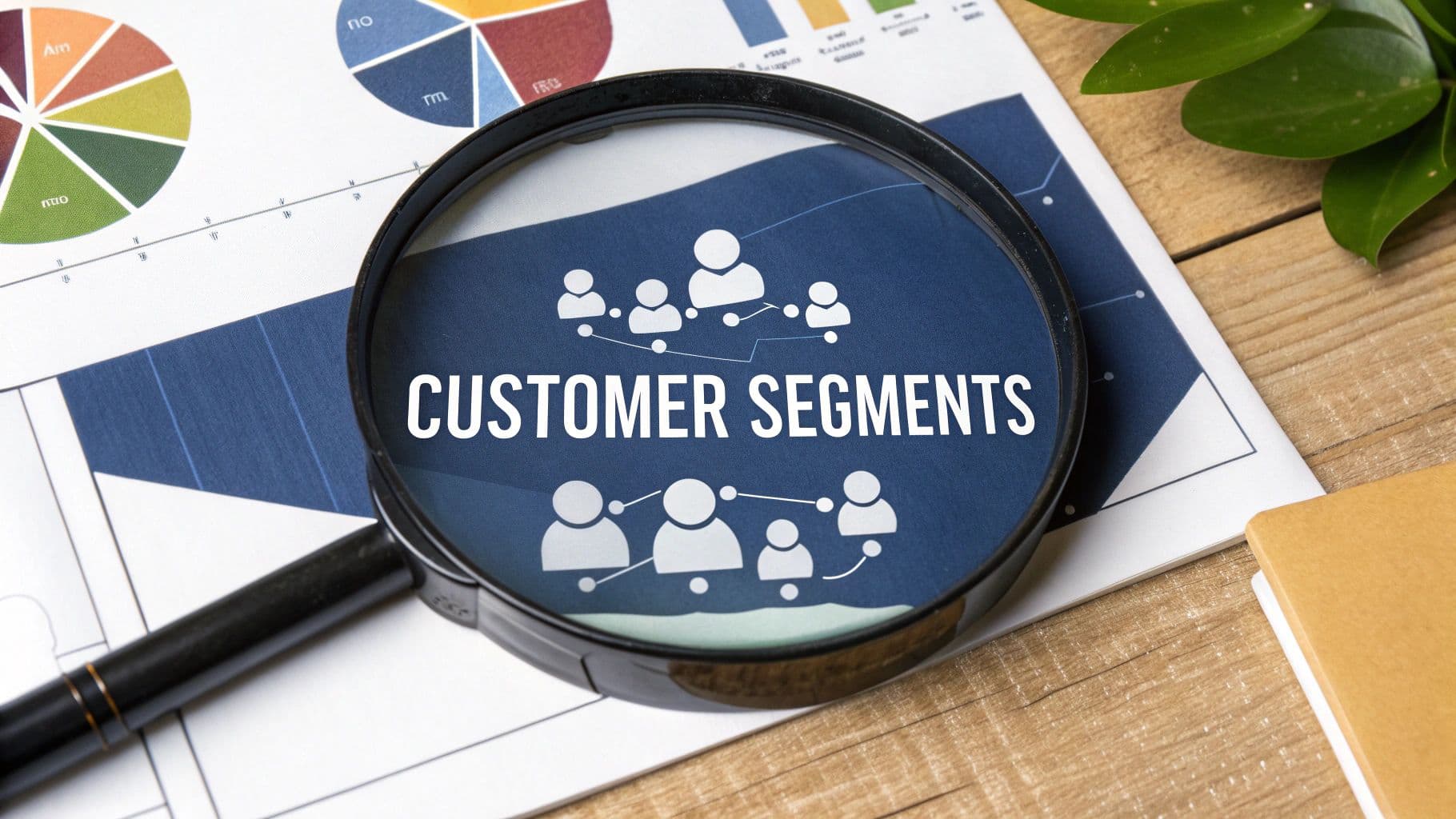Mastering Customer Retention Rate for Growth
Unlock sustainable growth by mastering your customer retention rate. Learn how to calculate it, what good benchmarks are, and proven strategies to improve it.
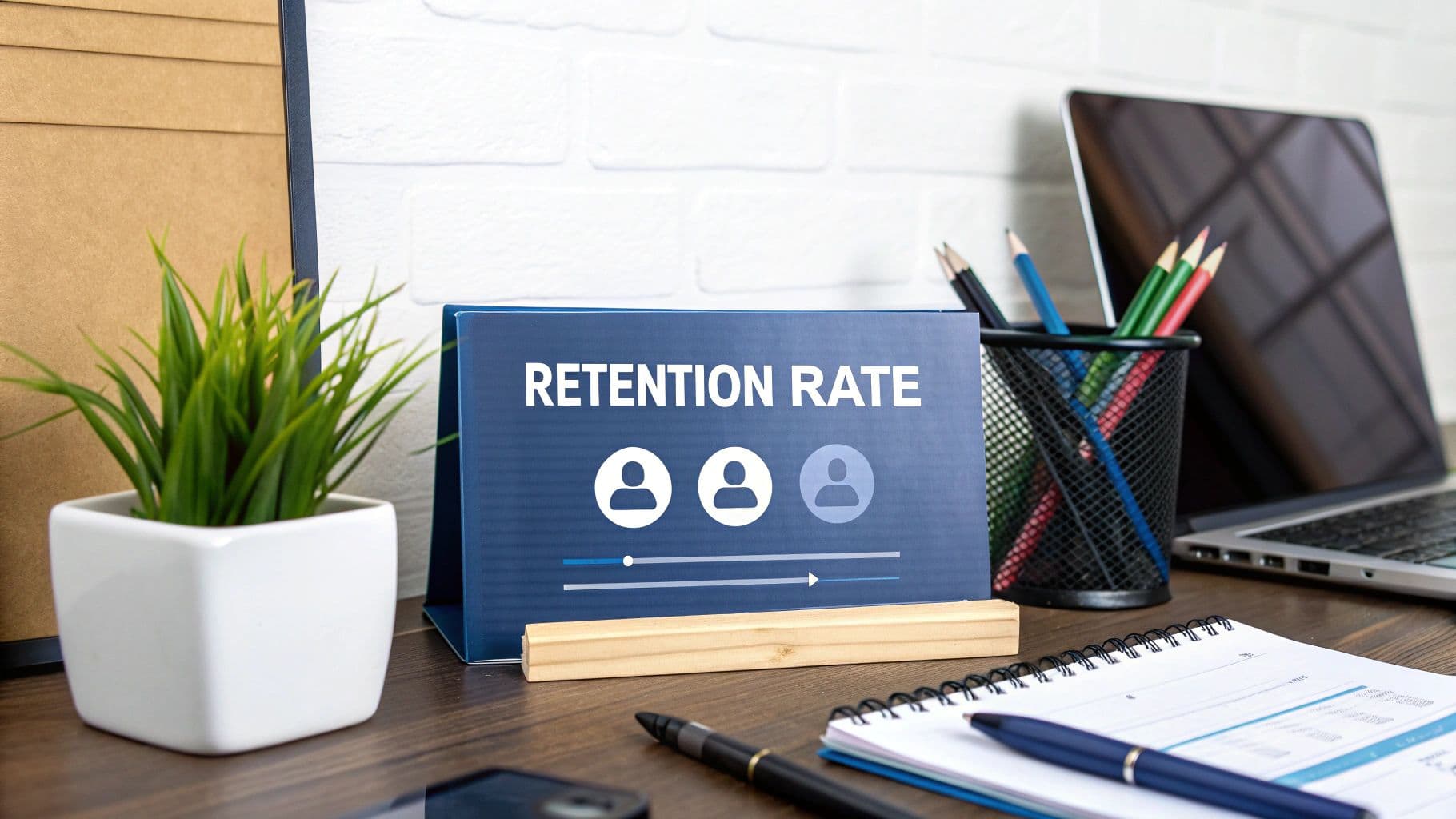
Your customer retention rate is simply the percentage of customers you hold onto over a set amount of time. But don't let its simplicity fool you. This single number says a lot about the health of your business and is one of the best predictors of your long-term success.
Why Customer Retention Is Your Real Growth Engine
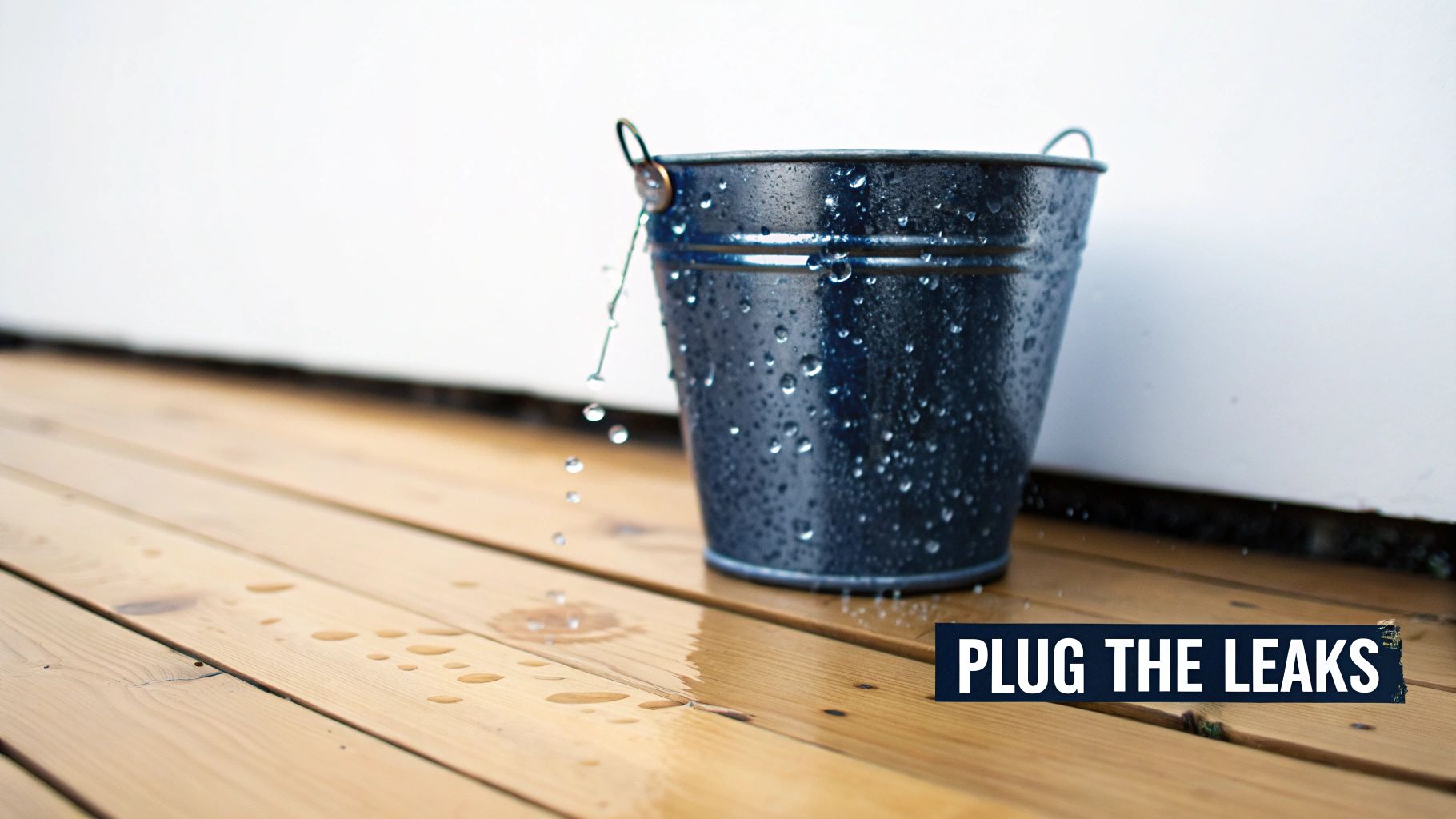
It's easy to get caught up in the chase for new customers. Many businesses pour the bulk of their marketing budget into acquisition, but this is like trying to fill a leaky bucket. You can keep pouring water in (new customers), but you'll never actually get ahead until you fix the holes. Mastering your customer retention rate is how you patch that bucket for good.
This isn't just a convenient metaphor; it's a core business reality. Holding onto the customers you already have is far more profitable than constantly finding new ones. The data backs this up time and time again. Research has shown that boosting customer retention by just 5% can increase profits anywhere from 25% to 95%.
The reason is simple: loyal customers trust you. They spend, on average, 67% more than new customers do, and a massive 65% of a company’s business typically comes from its existing customer base. You can explore more customer retention statistics on firework.com.
The Strategic Shift from Acquisition to Loyalty
When you start prioritizing retention, you're not just tweaking a metric—you're changing your entire approach to growth. The focus moves away from the endless, expensive hunt for new buyers and toward nurturing the relationships you've already built. This creates a powerful cycle that strengthens your business from the inside out.
Happy, long-term customers are an incredible asset. Here’s why:
- They're More Profitable: It costs much less to keep a customer than to find a new one. Plus, they're more likely to buy from you again, try new products, and spend more over their lifetime.
- They Create Predictable Revenue: A high retention rate gives you a stable, recurring stream of income. This makes financial planning easier and your business more resilient.
- They Become Your Best Marketers: There's no advertising more powerful than a happy customer. They leave great reviews, recommend you to friends, and provide the kind of social proof that brings in high-quality leads—for free.
- They Give You Invaluable Feedback: Your long-term customers know your product inside and out. Their insights are pure gold for spotting opportunities to improve and figuring out what to build next.
Ultimately, your customer retention rate is more than a number on a dashboard. It's the pulse of your business, showing you how much real value you're delivering. By focusing on keeping the customers you’ve worked so hard to win, you unlock a much smarter and more sustainable path to success. This guide will walk you through exactly how to measure, understand, and improve it.
How to Calculate Your Customer Retention Rate
Figuring out your customer retention rate (CRR) might sound like a job for a data analyst, but it's actually pretty simple. It's one of the most honest measures of customer loyalty you can track, and you don’t need any fancy software to get it done. All it takes is three numbers and one basic formula.
Think of it like taking a quick headcount at a party. To know who stuck around, you need to know how many people were there at the start, how many were there at the end, and who the new arrivals were. The goal is to isolate the original crowd that stayed with you.
The Core Retention Formula
Getting to your CRR is a straightforward, three-step process. First, you figure out how many existing customers you held onto. Then, you see how that group stacks up against the number of customers you started with. Finally, you turn that into a percentage.
Here’s the universal formula everyone uses:
Let’s quickly unpack what those letters mean:
- E = The total number of customers you have at the end of your chosen time period.
- N = The number of new customers you signed up during that same period.
- S = The number of customers you had at the very start of the period.
The magic happens when you subtract your new customers (N) from your final count (E). What’s left is the number of loyal customers who were with you from the beginning.
Putting the Formula into Action
Let's walk through a real-world example to make this stick. Imagine you run a subscription coffee box service and want to calculate your CRR for the first quarter (January 1st to March 31st).
Here’s the data you’ll need:
- Customers at the Start (S): On January 1st, you had 500 active subscribers.
- Customers at the End (E): By March 31st, your subscriber list has grown to 580.
- New Customers Acquired (N): Over those three months, you brought in 120 new subscribers.
Now, we just plug those numbers into the formula:
- Isolate your retained customers: Subtract the new customers from your total at the end of the quarter.
580 (E) - 120 (N) = 460- This tells you that 460 of your 580 subscribers were part of the original group.
- Divide by your starting customers: Next, see what portion of your initial customer base that number represents.
460 / 500 (S) = 0.92- Simple enough. You kept 92% of the customers you started with.
- Turn it into a percentage: To get the final CRR, just multiply by 100.
0.92 x 100 = 92%- And there you have it. Your customer retention rate for Q1 is an impressive 92%.
Choosing the Right Time Frame
Should you measure this monthly, quarterly, or annually? It really depends on your business model. Each timeframe gives you a different, valuable perspective.
- Monthly: This is perfect for businesses with fast-paced cycles, like SaaS companies or mobile apps. It helps you catch problems early before they snowball.
- Quarterly: This is a popular middle ground. It smooths out any random monthly dips or spikes, giving you a more stable view for planning your next moves.
- Annually: This calculation gives you the big-picture view of long-term loyalty. It's fantastic for year-over-year comparisons and for reporting to investors or stakeholders.
Of course, calculating your CRR is just the first step. Understanding the "why" behind the number is where the real work begins. To get a fuller picture, it’s a good idea to explore other essential customer retention metrics that can tell you more about why people decide to stay or go.
What a Good Customer Retention Rate Really Looks Like
So, you’ve calculated your customer retention rate. The next question is almost always, "Is this number any good?"
Honestly, there’s no simple yes or no. A “good” CRR is completely relative. It depends on your industry, your business model, and the kind of relationship you have with your customers.
Trying to compare a SaaS company that relies on annual contracts with a local coffee shop that sees customers daily is like comparing apples and oranges. One is built on long-term commitment, the other on frequent, small purchases. Their retention goals are going to be worlds apart.
That's why the first step to evaluating your performance is to forget about universal averages. You need to look at benchmarks for your specific industry to get a realistic picture of where you stand.
The infographic below breaks down the retention formula into its core parts, showing how your starting customer count, new additions, and final numbers all fit together.
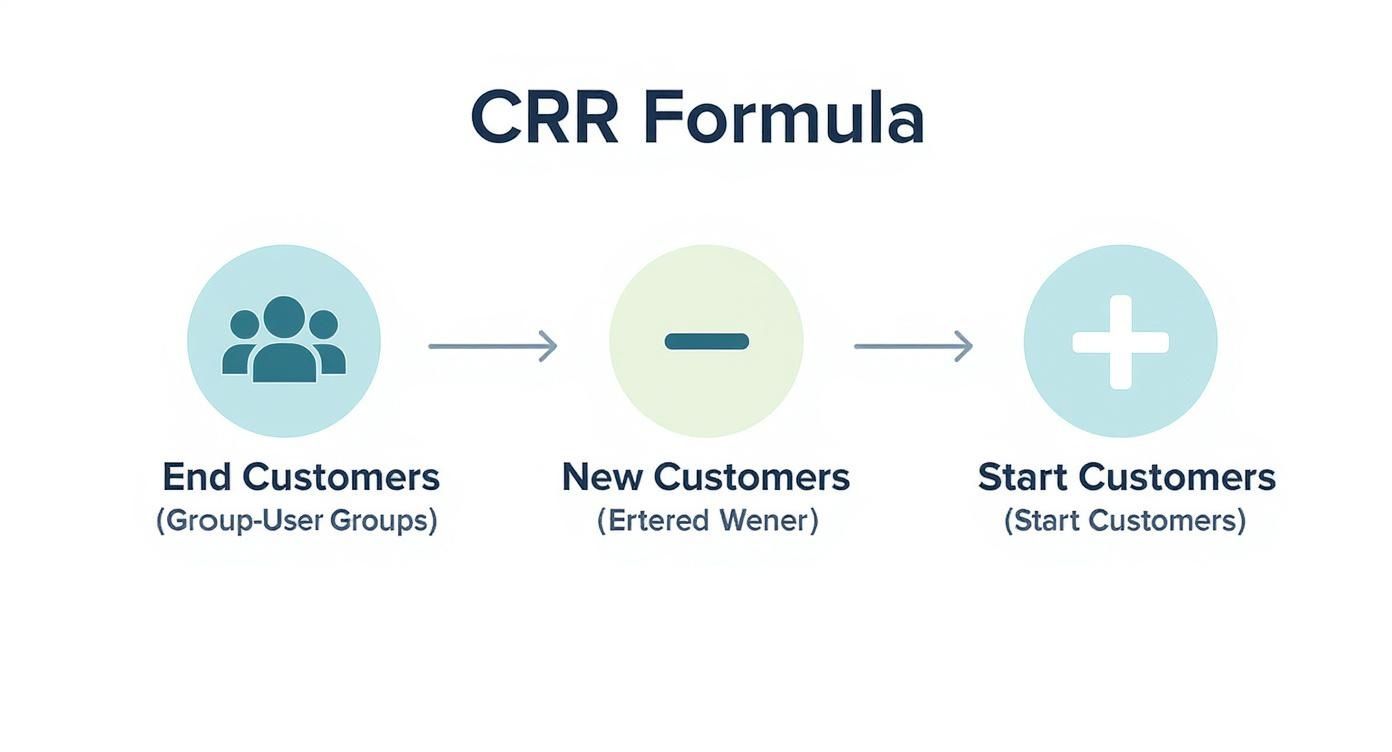
It’s a great visual reminder that the whole point is to see how many of the customers you started with are still with you at the end.
Industry Benchmarks for Customer Retention
Every industry plays by its own rules when it comes to customer loyalty. Businesses with subscriptions, high switching costs, or constant customer interaction tend to have an easier time keeping people around. On the other hand, sectors with fierce competition and no real barriers to leaving often see customers come and go.
The differences can be huge. Globally, the media and professional services sectors are at the top of the pack, holding onto an impressive 84% of their customers. At the other end of the spectrum, hospitality, travel, and restaurants struggle with an average of just 55%. E-commerce faces its own uphill battle, with a typical retention rate of around 38%, which really shows how hard it is to build lasting loyalty online. You can discover more insights about these retention rate benchmarks to dig into how different fields stack up.
To give you a clearer idea, here’s a look at how average retention rates shake out across a few key industries.
Customer Retention Rate Benchmarks By Industry
This table compares average customer retention rates across various global industries, offering some valuable context for your own company's performance.
| Industry | Average Customer Retention Rate |
|---|---|
| Media & Entertainment | 84% |
| Professional Services | 84% |
| IT Services & SaaS | 81% |
| Financial Services & Insurance | 78% |
| Telecommunications | 78% |
| Retail & E-commerce | 63% |
| Hospitality, Travel & Restaurants | 55% |
As you can see, context is everything. A 60% retention rate might set off alarm bells for a SaaS company, but in the restaurant world, it could be a sign you're doing something very right.
Why Retention Rates Differ So Much
So, why the massive gap between industries? A few key factors are at play, and understanding them can help you see where you can make strategic improvements.
- Business Model: Subscription-based companies (think SaaS or streaming services) have a natural advantage. Customers have to actively decide to leave. Transactional businesses, like retail, have to win back that loyalty with every single purchase.
- Purchase Frequency: How often do customers interact with you? A coffee shop has daily opportunities to build a loyal following. A car dealership or a real estate agent might only see a customer once a decade, making the retention game much longer and more complex.
- Switching Costs: Think about how hard it is for a customer to jump ship to a competitor. If your software is deeply woven into a client's daily workflow, the cost and hassle of switching are high, which is great for your retention.
To get real value from these numbers, you often have to go deeper. Breaking down retention by specific customer groups—or cohorts—can show you who your most loyal customers are and why they stick around. This kind of detailed view helps you move past a single, generic metric and start building retention strategies that actually work. If you're ready to take that next step, this guide on cohort retention analysis is a great place to start.
Proven Strategies to Improve Customer Retention
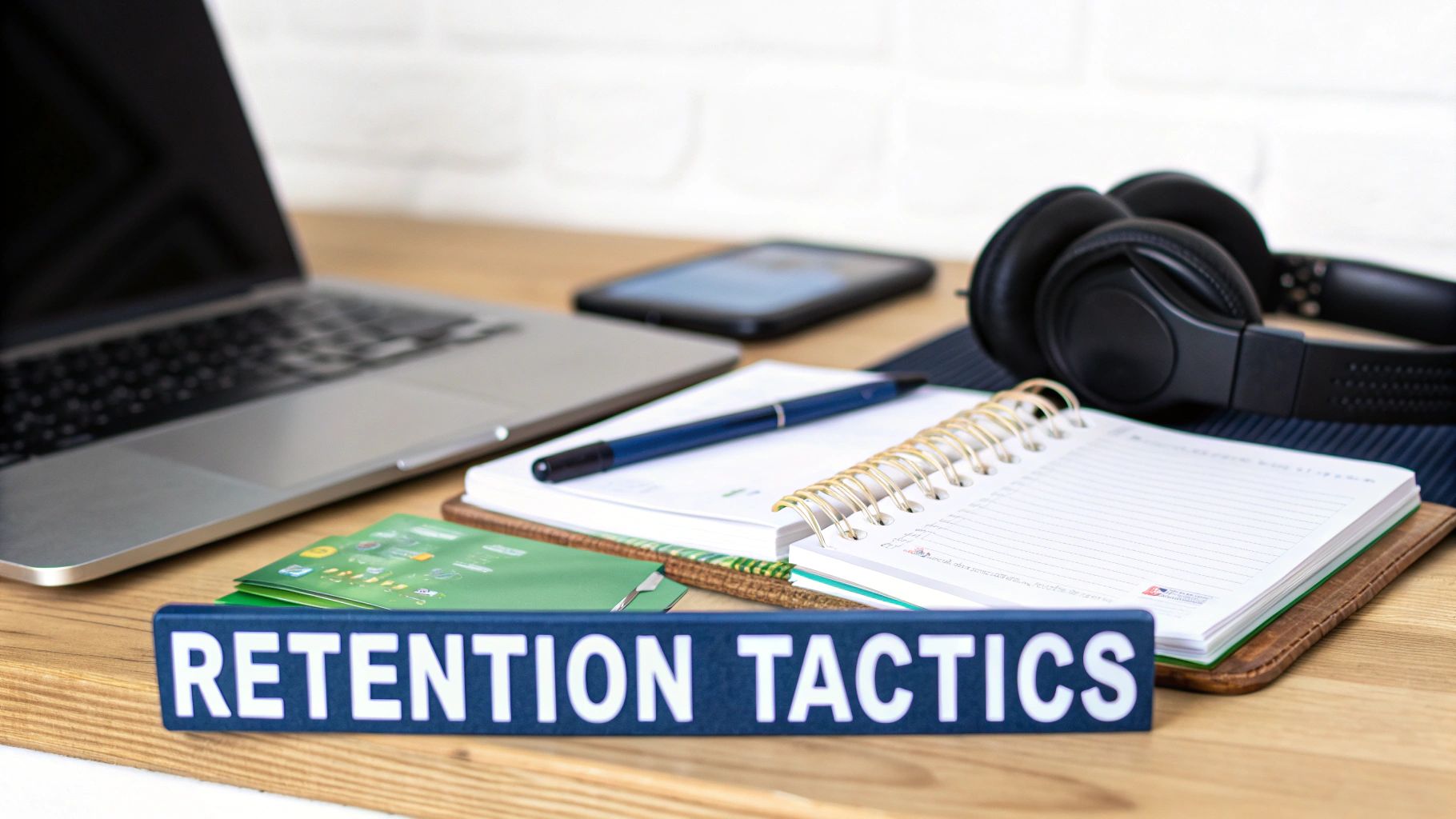
Knowing your customer retention rate is like taking your business's pulse—it tells you how healthy your customer relationships really are. But a number is just a number until you do something with it. So, let's move past the theory and dig into the practical, proven strategies that turn first-time buyers into lifelong fans.
Boosting retention isn't about one big, flashy campaign. It’s about the small, consistent things you do every day to make your customers feel valued. The real goal is to weave your product or service so seamlessly into their lives that the thought of switching to a competitor feels like a major step backward.
Build a Loyalty Program That Adds Real Value
A great loyalty program is so much more than a marketing gimmick. It’s a powerful way to acknowledge and reward your best customers, making them feel like true insiders. But let’s be honest, a generic punch card or a confusing points system just doesn’t cut it anymore. For a program to work, its value has to be obvious, immediate, and genuinely useful.
Think beyond the usual discounts. What exclusive perks can you offer that truly improve their experience?
- Early Access: Let your loyal members be the first to try new products or features. It’s a simple gesture that creates a feeling of exclusivity.
- Exclusive Content: Offer access to members-only webinars, in-depth tutorials, or industry reports that aren't available to the general public.
- Tiered Rewards: Structure your program with levels (think Bronze, Silver, Gold) that unlock better benefits as customers engage more. This encourages them to deepen their relationship with your brand over time.
The best programs foster a sense of community, not just a series of transactions. That feeling of belonging is what builds lasting commitment.
Deliver Proactive Customer Support
Good customer support is reactive—a customer has a problem, they call you, and you fix it. But truly exceptional support is proactive. It’s about anticipating issues and solving them before your customers even know something is wrong. This shows you're not just waiting for things to go sideways; you're actively invested in their success.
This means using your data to get ahead of common problems. For instance, if you see a user is struggling with a certain feature in your software, you could automatically trigger a pop-up guide or email them a helpful video tutorial. You've just turned a moment of potential frustration into a surprisingly helpful and positive interaction.
Use Personalization to Make Customers Feel Seen
We’re all bombarded with generic marketing messages every day. Personalization is what cuts through that noise. It's the difference between making a customer feel like another entry in a database and making them feel like a valued individual whose needs you actually understand.
And I’m not just talking about using their first name in an email. Real personalization uses a customer's past behavior to tailor their entire experience.
- Product Recommendations: Suggest products based on their purchase history—things they'll genuinely love, not just your bestsellers.
- Customized Communication: Send tips or updates relevant to how they use your service, like highlighting features they engage with most.
- Personalized Onboarding: When a new user signs up, guide them based on the goals they want to achieve, showing them the fastest way to get value.
This kind of attention to detail proves you’re offering a tailored solution, not just a one-size-fits-all product.
Gather and Act on Customer Feedback
Your customers are giving you a roadmap for how to keep their business. The only question is whether you’re paying attention. Creating a reliable system to collect, analyze, and—most importantly—act on customer feedback is non-negotiable for improving retention.
Don't wait until a customer cancels to find out why they were unhappy. Use regular feedback loops to catch friction points early on.
- Surveys: Send out regular Net Promoter Score (NPS) or Customer Satisfaction (CSAT) surveys to keep a finger on the pulse of customer sentiment.
- In-App Feedback: Make it effortless for users to report a bug or suggest an improvement right from within your app or website.
- Customer Interviews: Talk to your customers! Schedule calls with a mix of your biggest fans and those at risk of churning to get rich, qualitative insights.
Remember, the most crucial part is closing the loop. When you make a change based on someone's feedback, circle back and let them know. It’s a powerful way to show that you're listening and that their voice truly matters.
As customer expectations rise, these strategies become even more critical. While email is still a go-to tool for 89% of businesses, 60% of customers point to great service as the number one reason they stick around. At the same time, 59% of sales leaders see loyalty programs as their most effective tactic—a view backed by the 92% of consumers who belong to at least one. To build on this, you can discover more insights about customer retention statistics on thesalescollective.com.
Using AI to Predict and Prevent Customer Churn
Most retention strategies, as effective as they are, tend to be reactive. You spot a dip in your customer retention rate, dig into the why, and then scramble to fix the problem. But what if you could step in before a customer even starts thinking about leaving?
This is where artificial intelligence stops being a buzzword and becomes a real-world business advantage.
Think of it this way: traditional retention is like a doctor treating a patient who's already sick. An AI-powered approach is like a geneticist who spots a predisposition to an illness and prescribes a preventative plan years in advance. It's a fundamental shift from reactive damage control to proactive relationship management.
AI platforms, like our own SigOS, can chew through massive amounts of data that would overwhelm any human team. They analyze everything from purchase history and website clicks to support ticket language and how often features are used. Buried in all that noise, AI finds the faint signals that show a customer is starting to drift away.
How AI Spots At-Risk Customers
AI isn't making a wild guess; it's spotting patterns. By analyzing all your historical data, it learns what a customer's behavior looks like right before they cancel their account. This process often uncovers subtle connections that are invisible to the naked eye but are incredibly reliable predictors of churn.
These insights are pure gold for any team trying to boost its customer retention rate. Here’s how AI turns that data into something you can act on:
- Behavioral Red Flags: An AI might discover that customers who suddenly abandon a key feature are 80% more likely to cancel within the next 30 days.
- Sentiment Analysis: It can scan support chats and emails for words that signal frustration, even if a customer never directly says, "I'm unhappy."
- Usage Dips: A slow, steady decline in how often someone logs in or how long they stay can be an early warning that they're losing interest.
The magic isn't in looking at just one of these things. It's in the AI's ability to connect dozens of tiny data points to generate a single, straightforward "churn risk score" for every customer.
By flagging these customers early, you open up a crucial window of opportunity. You can intervene with a helpful offer, a personalized check-in, or a reminder of the value you provide—all before they’ve made up their mind to leave.
Turning Predictions into Proactive Retention
Knowing who is likely to churn is only half the battle. The next step is getting strategic with your response. This is where AI moves from a simple analytics tool to a core part of your retention engine, helping your teams work smarter, not harder.
For example, an AI-driven platform can automatically kick off specific actions based on a customer's unique risk score and behavior. This lets you build a personalized, scalable system for preventing churn.
Practical AI-Powered Retention Tactics:
- Automated Re-Engagement Campaigns: If a customer's risk score crosses a certain line, the system can automatically enroll them in a targeted email sequence. The emails might highlight features they aren't using or offer a quick one-on-one call with a success manager.
- Real-Time Support Agent Insights: Picture a support agent in a live chat. An AI-powered alert pops up on their screen: "High churn risk. This customer hasn't used the reporting feature in a month." Armed with that context, the agent can guide the conversation and solve the underlying problem, potentially saving the account right then and there.
- Prioritizing Product Fixes: AI can also show you which product flaws are costing you the most money. By connecting specific bugs or missing features to churn, platforms like SigOS help your product team focus on the fixes that will have the biggest impact on your overall customer retention rate.
Turning Retention Insights Into Sustainable Growth
We've covered a lot of ground, from defining customer retention rate to unpacking the strategies that actually work. But if there’s one thing to take away, it’s this: retention isn't just another metric on your dashboard. It’s an active, daily practice that should be woven into the fabric of your company. It’s the most durable path to building a business that lasts.
So many companies fall into the trap of pouring all their resources into filling a leaky bucket. Real, sustainable growth comes from plugging the leaks by creating experiences so valuable that customers have no reason to leave. That means getting obsessed with not just that customers are leaving, but digging deep to understand why—and using that knowledge to improve, every single day.
From Data To Decisive Action
Shifting to a retention-first mindset isn't just about good intentions. It’s about connecting the dots between your data and your day-to-day operations.
Here's how you can start making that happen:
- Know Your Number: Start by calculating your CRR. You can't improve what you don't measure, and this gives you a clear, honest baseline.
- Get Some Context: How does your rate stack up? Compare it against industry benchmarks to set ambitious but achievable goals for your team.
- Be Proactive, Not Reactive: Don't wait for customers to complain. Build genuine relationships with loyalty programs, personalized outreach, and stellar customer support.
- Embrace Modern Tools: Use AI-powered platforms to see around corners, predicting which customers are at risk and highlighting opportunities before they slip away.
This approach flips the script, turning retention from a look-back metric into a powerful predictor of your future success. Every customer you keep isn't just another transaction; they are a compounding asset. Their value grows far beyond what they spend, as their trust and word-of-mouth become your most powerful marketing engine. You can see just how impactful this is when you start calculating customer lifetime value for your SaaS business.
The goal isn't just to grow by acquiring new customers. It's to build a business that thrives on the deep, lasting value you deliver to the people who already believe in you.
Now, the ball is in your court. Don't let this be just another article you read and forget. Take one small, concrete step this week: calculate your current customer retention rate. Then, pick just one new strategy from this guide and commit to it for the next 90 days. The future of your business will thank you for it.
Got Questions? We've Got Answers
Even after you've got the basics down, a few practical questions always pop up when you start tracking customer retention. Let's clear up some of the most common ones so you can measure this metric with confidence.
Customer Retention vs. User Retention: What's the Difference?
This is a critical distinction, particularly if you're a B2B company. Think of it this way:
- Customer retention counts the number of paying accounts you hold onto. It's about the company that signs the check.
- User retention tracks how many individual people at that company are actively using your product.
For a B2C business, these two numbers are usually one and the same. But for B2B, they tell very different stories. You could have perfect customer retention—the company renews its contract—but terrible user retention because their employees never log in. That's a huge red flag. It tells you the account isn't seeing real value and is a major churn risk down the road.
Is a High Retention Rate Better Than a Low Churn Rate?
This sounds like a trick question, but it’s really about perspective. They are two sides of the same coin. If you have a 90% retention rate, you have a 10% churn rate. Simple as that.
The real difference is in the mindset it encourages. Focusing on retention pushes your team to be proactive—to constantly deliver value and build strong relationships. Talking about churn often puts you in a reactive mode, scrambling to figure out what went wrong after a customer has already walked out the door. While both metrics are important, framing your goals around retention helps build a healthier, more customer-focused culture.
Do I Count Free Trial Users in My Calculation?
In most cases, the answer is no. The standard customer retention formula is all about measuring the loyalty of your paying customers.
Tossing free trial users into the mix can really muddy the waters, since they haven't made a financial commitment yet. It's much cleaner to track your trial-to-paid conversion rate as a separate, vital metric. This keeps your CRR pure, focused squarely on the customers who drive your revenue.
The most important rule? Be consistent. Whatever you decide—whether to include a certain customer segment or not—stick with it. That way, when you compare your retention rate month after month, you know you're always comparing apples to apples.
Keeping these points in mind will help you get a clear, accurate picture of how well you're building lasting relationships with the people who matter most: your customers.
Ready to stop guessing what's driving churn? SigOS uses AI to analyze customer feedback and behavior, pinpointing the exact issues that cost you money and the opportunities that drive growth. Discover how SigOS can improve your customer retention rate.
Keep Reading
More insights from our blog

